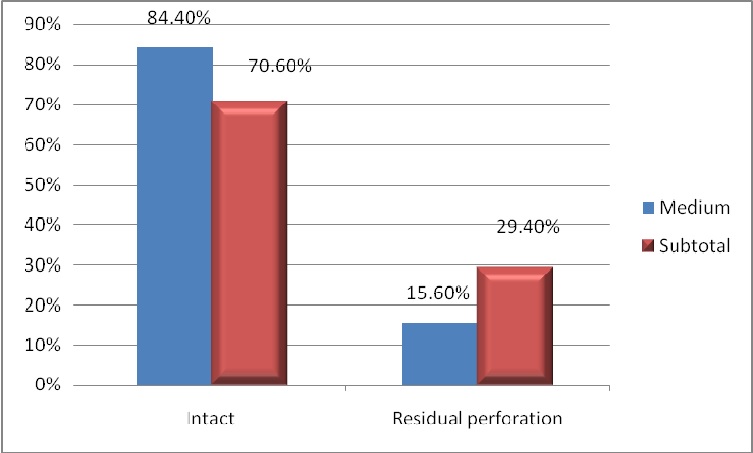A comparative study on type I tympanoplasty with or without mastoidectomy in chronic otitis media-mucosal disease
Abstract
Introduction: This comparative study evaluates the outcomes of type 1 tympanoplasty with or without mastoidectomy in chronic otitis media, mucosal disease in a tertiary care institute.
Materials and methods: The study included 84 patients with mucosal type of ear disease in quiescent stage .42 of these patients underwent type 1 tympanoplasty alone [Group A] and 42 underwent type 1 tympanoplasty with mastoidectomy [Group B]. Patients were followed up in the outpatient clinic at one week, third week, three months, and six months after the surgery. At third and sixth month the patients underwent otoscopic evaluation and hearing assessment.
Results: 19% of the patients who underwent Type I tympanoplasty had residual perforation at 6 months when compared with 14% of the patients of cortical mastoidectomy with Type I tympanoplasty which was statistically insignificant in this study. In group B out of 7 patients who had diseased mastoid status per operatively 4 had residual perforation which was significant [p<0.05].
Conclusion: In this study the comparison of results between groups A & B is statistically insignificant. Disease status of mastoid proved to be a significant factor for success of surgery. Belfast rule of thumb proved to be a better method to assess the post-operative hearing improvement subjectively.
Downloads
References
2. Chronic Suppurative Otitis Media- Burden of Illness and Management Options, Child and Adolescent Health and Development Prevention of Blindness and Deafness, World Health Organization, Geneva, Switzerland 2004: 10-14
3. David S. Haynes, MD Justin Wittkopf, MD- Canal wall up mastoidectomy, Shambaugh ear surgery 6th edition chapter 30: 502.
4. Aristides Athanasiadis- Sismanis Tympanoplasty: tympanic membrane repair, Shambaugh ear surgery 6th edition chapter 28: 465.
5. Chavan S, Deshmukh S,Pawar V, Khobragade S, Sarvade K, [2011] . Tympanoplaty with and without cortical mastoidectomy for tubotympanic type of chronic suppurative otitis media. Otolaryngol Head Neck Surg 8 [1]: 8-10.
6. A Ravikumar, A Chawdery, K Senthil. Hearing benefit in middle ear reconstructive surgery: A comparative study of current methods. Indian J Otolaryngol Head Neck Surg2005; Jul;57[3]: 210-214.
7. Saha AK, Munsi DM, Ghosh SN. Evaluation of improvement of hearing in type I tympanoplasty & its influencing factors. Indian J Otolaryngol Head Neck Surg. 2006 Jul;58(3):253-7. doi: 10.1007/BF03050833.[pubmed]
8. Mishiro Y, Sakagami M, Takahashi Y, et al. Tympanoplasty with and without mastoidectomy for non-cholesteatomatous chronic otitis media. Eur Arch Otorhinolaryngol. 2001 Jan;258(1):13-5.[pubmed]
9. Krishnan A, Reddy EK, Chandrakiran C, et al. Tympanoplasty with and without cortical mastoidectomy - a comparative study. Indian J Otolaryngol Head Neck Surg. 2002 Jul;54(3):195-8. doi: 10.1007/BF02993102.[pubmed]
10. McGrew BM , Jackson CG, Glasscock ME 3rd. Impact of mastoidectomy on simple tympanic membrane perforation repair. Laryngoscope. 2004 Mar;114(3):506-11.[pubmed]
11. Holmquist J, Bergström B. The mastoid air cell system in ear surgery. Arch Otolaryngol. 1978 Mar;104(3):127-9.[pubmed]
12. Jackler RK, Schindler RA. Role of the mastoid in tympanic membrane reconstruction. Laryngoscope. 1984 Apr;94(4):495-500.[pubmed]
13. Nayak D R, Balakrishnan R, Hazarika P, Mathew P T. role of cortical mastoidectomy in the results of myringoplastyfor dry ear 104;127-129.
14. Balyan FR , Celikkanat S, Aslan A, et al. Mastoidectomy in noncholesteatomatous chronic suppurative otitis media: is it necessary? Otolaryngol Head Neck Surg. 1997 Dec;117(6):592-5.

Copyright (c) 2018 Author (s). Published by Siddharth Health Research and Social Welfare Society

This work is licensed under a Creative Commons Attribution 4.0 International License.


 OAI - Open Archives Initiative
OAI - Open Archives Initiative



















 Therapoid
Therapoid

